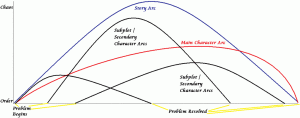Before we jump in, I’ll be including a new feature called Try This! after the tip. You can use it to test your writing against the topic, or just practice the technique. Today’s topic is Story Arc. Writer Abigail Thomas once opened a workshop by saying, “If I hear the term ‘story arc’ once more, I’ll scream.” While “arc” has been a writing buzz word, it’s an aspect of fiction that needs to be in place on several levels. Even if you’re as fed up hearing about story arc as Thomas, it pays to get it right. Two good resources are Story by Robert McKee and Writing the Breakout Novel by Donald Maass.
Writing Tip for Today:
Writing Tip for Today:
- First, what is story arc? Think of it as an important structural element, the story bones. Story arc is the overall story shape, and it charts the rise of action, the climax and its resolution.
- Begin at the inciting incident, which simply means the event or change that sets the story into motion. Think of inciting incident as the point after which nothing will ever be the same.
- After the story’s inciting incident, events must successively rise in both tension and importance to the story’s outcome. Things get worse.
- The climax comes near the story’s end. The climax is your protagonist’s do or die moment. No more dithering. Character must act.
- The resolution is the last bit of the arc, where the action and tension level off. They lived happily ever after (or not)–end the story as quickly as possible.
In addition to this classic story arc, your main character and supporting cast need their own character arcs, which shows how they grow and change over the course of the story.
Try This! (new feature) Draw an arc for your story in progress. Start at the bottom for the inciting incident, and draw an arch for marking critical scenes along it, culminating at the high point, the climax scene. The resolution will be the only spot on the arc that dips down after the climax. Does your WIP conform to this model? If not, what’s your reasoning for telling the story this way?
Coming up: The Inciting Incident: Start your story at the right time and place.






I think Im going to like this. Cant wait for the next post.
Linda, I came here from Lori Benton’s blog and am thrilled! Your blog is filled with such excellent advice. Your post on story arc reminded me that I need to draw mine out again as I’m now working on my synopsis. It will help me gage my work. This is a tool that sometimes I keep in mind, but it’s so much better to diagram it out on paper (I’ve printed out your illustration). Thanks so much!
Blessings,
Carla
http://writingtodistraction.blogspot.com